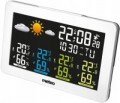Indoor measuring range
The temperature range at which the weather station's internal temperature sensor (see "Measurements") can operate normally. Of course, for normal use, it is need to the temperatures in the room do not go beyond the specified range — otherwise the device will give a warning about the impossibility of measurements in the best case, and at worst it will fail altogether. However, it should be noted here that temperature fluctuations inside residential and office buildings are relatively small, and even in the most inexpensive weather stations, the operating range of the corresponding sensors covers these fluctuations with an impressive margin. Therefore, it makes sense to pay close attention to the measurement temperature in the room only when the device is purchased for non-standard applications — for example, for installation in a greenhouse or in a warehouse with low temperatures.
Outdoor measuring range
The temperature range for which the external temperature sensor of the weather station is designed (see "Measurements"). This parameter must correspond to the temperature differences that this sensor may be exposed to during operation — otherwise, malfunctions and even hardware failures are possible. Of course, it is worth choosing a model according to external temperature, taking into account the climate in which it is planned to be used; at the same time, it is worth taking a certain margin both in the lower and in the upper side. The last is connected not only with the possibility of climatic fluctuations, but also with the fact that outdoor equipment can be heated from direct or reflected sunlight; this, of course, must be avoided in every possible way, but it is not always possible to find an perfect fitting location for the sensor.
Comfort temperature
Ability to display
the comfort level on the display of the weather station.
The overall comfort of an individual in specific conditions relies not just on air temperature but also on factors like humidity and outdoor wind strength. Display features for comfort levels vary between indoor and outdoor conditions. Indoors, the device typically assesses the combination of temperature and humidity, offering an overall comfort conclusion ranging from "good/bad" to intermediate options. Outdoors, it introduces the concept of "perceived temperature." This accounts for the impact of strong winds and/or high humidity, where the air feels colder than the actual temperature suggests. For instance, -5 °C with these conditions might feel as unpleasant as -8 °C in dry, windless weather. Perceived temperature data provides a more accurate assessment of external conditions, aiding individuals in making informed decisions, such as choosing appropriate clothing.
Modern weather stations can support either the first or second option separately, or both. Anyway, working with a comfort level implies at least the possibility of measuring humidity (see above).
Installation
The weather station's design includes specified placement options for the main unit. While this parameter can be somewhat flexible — such as wall-mounted devices used on tables or creative methods for hanging tourist models on walls — only standard options explicitly stated by the manufacturer are considered in this context. Some models may offer multiple claimed placement options.
—
Desktop. Placing the weather station on a table or a similar surface, like a shelf or window sill, is a straightforward and effortless installation method. It provides convenience, allowing for easy relocation when needed. However, the limitation lies in the availability of free surfaces, and there's a risk of inconvenience, such as accidentally knocking the device to the floor.
—
Wall. Mounting the weather station on the wall using a hook, nail, or similar device is a space-efficient option, offering flexibility in choosing installation height. This method minimizes occupied space, yet the installation process is more complex, often requiring wall drilling.
– Portable (tourist). Portable weather stations, intended for on-the-go use, are not meant for permanent installation, although that option is also feasible. Designed for hikers and travelers, these compact devices are pocket-sized, easily fitting into bags or backpacks. Their design may include features for easy attachment to equipment, su
...ch as handles or carabiners, but they typically lack options for table installation or wall hanging. Portable weather stations usually do not use external sensors, and their cases are reinforced for increased protection against dust and moisture.Dimensions
Dimensions of the main unit of the weather station. This option allows you to estimate the space required to install the device. However, most modern models are very compact, it makes sense to pay close attention to the dimensions only when you have to install the device in a very cramped place.

